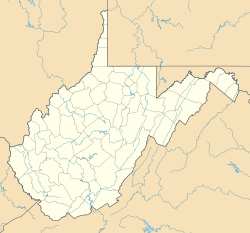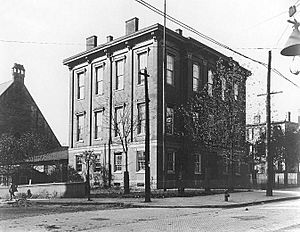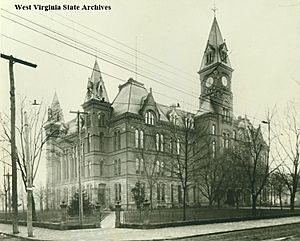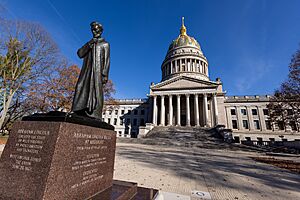West Virginia State Capitol facts for kids
Quick facts for kids |
|
|
West Virginia State Capitol
|
|
|
U.S. Historic district
Contributing property |
|

West Virginia State Capitol
|
|
| Location | 1900 Kanawha Boulevard East, Charleston, West Virginia, U.S. |
|---|---|
| Built | 1932 |
| Architect | Cass Gilbert |
| Architectural style | Neoclassical |
| Part of | West Virginia Capitol Complex (ID74002009) |
| Added to NRHP | December 31, 1974 |
The West Virginia State Capitol is where the government of West Virginia works. It's like the main office for the state! This important building holds the West Virginia Legislature, which makes laws. It's also where the Governor of West Virginia has their office.
You can find the Capitol in Charleston, West Virginia. It was officially opened in 1932. The Capitol and the nearby West Virginia Executive Mansion together form the West Virginia Capitol Complex. This whole area is a special historic place listed on the National Register of Historic Places.
Contents
How West Virginia Chose Its Capital
Before the American Civil War, the land that is now West Virginia was part of Virginia. Back then, the state capital was in Richmond, Virginia. But in 1861, Virginia left the United States. The counties in northwestern Virginia stayed loyal to the U.S. They started a process to create their own state. West Virginia officially became a state on June 20, 1863.
Choosing a capital city for the new state was tricky! For several years, the capital moved between Wheeling and Charleston. Other cities like Martinsburg and Clarksburg were also suggested. Finally, the people of West Virginia voted. On August 7, 1877, they chose Charleston as their permanent capital.
West Virginia's Early Capitol Buildings
West Virginia has had several capitol buildings over the years. It was quite a journey to find a permanent home for the state government!
Wheeling's First Capitol: 1863-1870
When West Virginia first became a state in 1863, its lawmakers met in Linsly Military Institute in Wheeling. This building was on Eoff Street.
The government quickly grew too big for the Linsly building. In 1865, the lawmakers decided to move the capital to Charleston. They stayed in Wheeling until a new building was ready in Charleston in 1870.
Charleston's First Capitol: 1870-1875
Work began on a new capitol building in downtown Charleston in 1869. This building was designed by Leroy S. Buffington. It had a mix of different architectural styles, making it look unique.
The legislature met here until 1875. Then, the city of Wheeling offered to build an even newer capitol. Wheeling was also easier to reach because Charleston didn't have train access yet. So, the government moved back to Wheeling.
Wheeling's Second Capitol: 1875-1885
The lawmakers returned to Wheeling in 1875. They used the Linsly building again until a brand new capitol was finished in 1876. This new building was very large and impressive.
The next year, people across the state voted again for a permanent capital. Wheeling was not even an option this time. Charleston was chosen! In 1877, Governor Jacob announced that Charleston would be the permanent capital after 1885.
After the new Charleston building was ready in 1885, the Wheeling capitol building was changed. It became the city hall and county courthouse. This building stood until 1959.
Charleston's Second Capitol: 1885-1921
Construction for Charleston's second capitol started in 1880. It was designed by Andrew Peebles. The older 1870 building was mostly torn down to make way for this new one.
This building was very different from the first. It had a more informal and artistic style. Sadly, a fire completely destroyed it in 1921. Only the outside walls were left, and they were soon taken down.
Charleston's Temporary Capitol: 1921-1927
After the fire, a temporary wooden building was quickly put up in 1921. People jokingly called it the "pasteboard capitol" because it was built so fast. It was on Washington Street, close to where the old capitol stood.
Everyone thought the new, permanent capitol would be built on the same spot. But a new location was chosen by the river in the eastern part of the city. The temporary capitol also burned down in a fire in 1927.
The Capitol Building Today
After all those moves and fires, a special commission was formed in 1921. Their job was to build the capitol we see today. Architect Cass Gilbert designed this beautiful building. It is made of light-colored limestone. The whole project cost almost $10 million.
Construction started in 1924. The first stone was laid on November 5, 1930. After three main building stages, Governor William G. Conley officially opened the capitol on June 20, 1932.
Cass Gilbert loved his design for the West Virginia Capitol's inside. He even used parts of it for the United States Supreme Court building! The U.S. Supreme Court chamber is a larger version of the one in West Virginia's East Wing.
Exploring the Capitol Grounds
The front of the Capitol building faces the Kanawha River. The entire area around the Capitol is called the capitol plaza. It's bordered by several streets, including Kanawha Boulevard East.
Besides the main Capitol, there are two other wings. They stick out from the main building, forming a large open space with a fountain in the middle. These wings are connected underground. The Governor's Mansion is also on the plaza. You can also find a cultural center and offices for many state departments here.
The grounds have several statues. One is of Abraham Lincoln near the front. It's called Abraham Lincoln Walks at Midnight. It shows President Lincoln, who was president when West Virginia became a state, walking with his head down. Another statue is of Stonewall Jackson, a famous person from West Virginia. There are also two large fountains.
You can also find the historic Holly Grove Mansion and the West Virginia Governor's Mansion on the complex. Across from the Capitol, near the river, is the Zero mile marker. This is where all highway distances in West Virginia are measured from.
If you want to visit, you can arrange tours of the Capitol through the West Virginia Culture Center.
Cool Facts About the West Virginia Capitol
The West Virginia State Capitol is the tallest building in the state! It stands at 292 feet (about 89 meters) tall.
| What to Know About the Capitol | Measurements |
|---|---|
| Height of the dome | 292 ft (89 m) |
| Width of the dome | 75 ft (23 m) |
| Total floor space | 525,000 sq ft (48,774 m2) |
| Weight of the chandelier in the dome | 4,000 lb (1,814 kg) |
| Weight of each bronze door | 2,800 lb (1,270 kg) |
| Height of the eagle on top of the dome | 5 ft (2 m) |
Gallery
-
A figure of Ceres in the West Wing.
-
A figure of Neptune in the West Wing.
-
A figure of Vesta in the West Wing.
See also
 In Spanish: Capitolio del Estado de Virginia Occidental para niños
In Spanish: Capitolio del Estado de Virginia Occidental para niños
- West Virginia Governor's Mansion
- List of West Virginia state legislatures
- List of state and territorial capitols in the United States
- List of tallest buildings in West Virginia






















